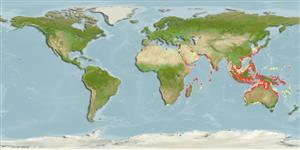Common names from other countries
>
Carangiformes (Jacks) >
Carangidae (Jacks and pompanos) > Caranginae
Etymology: Caranx: French, carangue, the name of a Caribbean fish; 1836 (Ref. 45335).
Environment: milieu / climate zone / depth range / distribution range
Ecologia
marinhas; estuarina associadas(os) a recifes; não migratória. Tropical; 34°N - 39°S, 19°E - 168°E
Indo-West Pacific: East Africa and Madagascar to Fiji, north to the Ryukyu Islands, south to northern Australia.
Comprimento de primeira maturação / Tamanho / Peso / Idade
Maturity: Lm 50.0 range ? - ? cm
Max length : 88.0 cm TL macho/indeterminado; (Ref. 90102); common length : 30.0 cm TL macho/indeterminado; (Ref. 5450); peso máx. publicado: 12.5 kg (Ref. 11228)
Espinhos dorsais (total) : 9; Raios dorsais (total) : 19 - 21; Espinhos anais: 3; Raios anais : 15 - 17. Dark bronze to yellow-green dorsally, shading to silvery bronze to yellowish or yellow green ventrally (Ref. 48635, 90102), yellow to dusky caudal fin and usually outer half of upper caudal lobe black (especially in juvenile) (Ref. 90102). Identified by black-tipped caudal fin (Ref. 48635). Body oblong and compressed, dorsal profile strongly convex to second dorsal fin, ventral profile slightly convex. Breast scalation variable, completely scaly (uncommon) to scaleless ventrally (Ref. 90102). LL with 30-40 strong scutes (Ref. 48635, 90102). Adipose eyelid moderately developed, small anteriorly and extending forward to rear edge of pupil o posterior part of eye. (Ref. 90102)
Adults inhabit clear coastal waters, over rocky reefs in small aggregations (Ref. 5213). Seldom found in turbid or estuarine waters. May be found solitary (Ref. 90102). They feed on fishes and crustaceans (Ref. 5213). Sold fresh and dried salted in markets. Excellent food fish if cooked properly (Ref. 12484).
Ciclo de vida ou comportamento de acasalamento
Maturities | Reprodução | Spawnings | Egg(s) | Fecundities | Larvas
Fricke, R., 1999. Fishes of the Mascarene Islands (Réunion, Mauritius, Rodriguez): an annotated checklist, with descriptions of new species. Koeltz Scientific Books, Koenigstein, Theses Zoologicae, Vol. 31:759 p. (Ref. 33390)
Status na Lista Vermelha da UICN (Ref. 130435)
CITES (Ref. 128078)
Not Evaluated
Ameaça para os humanos
Harmless
Uso pelos humanos
Pescarias: pouco comercial; peixe esportivo: sim
Ferramentas
Relatórios especiais
Baixar XML
Fontes da internet
Estimates based on models
Preferred temperature (Ref.
115969): 23.9 - 29, mean 27.9 (based on 1214 cells).
Índice de diversidade filogenética (Ref.
82804): PD
50 = 0.5000 [Uniqueness, from 0.5 = low to 2.0 = high].
Bayesian length-weight: a=0.02089 (0.01183 - 0.03689), b=2.94 (2.80 - 3.08), in cm Total Length, based on LWR estimates for this species & Genus-body shape (Ref.
93245).
Nível Trófico (Ref.
69278): 4.0 ±0.57 se; based on food items.
Resiliência (Ref.
120179): médio(a), tempo mínimo de duplicação da população 1,4 - 4,4 anos (Preliminary K or Fecundity.).
Fishing Vulnerability (Ref.
59153): High vulnerability (55 of 100).
